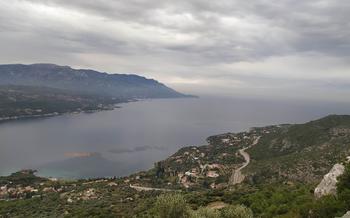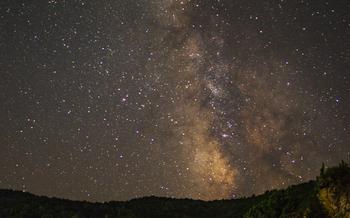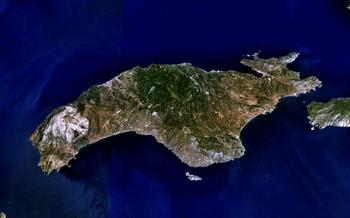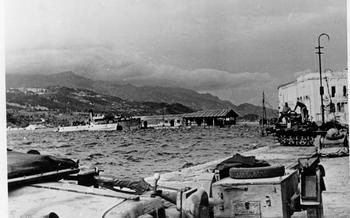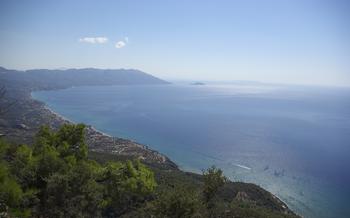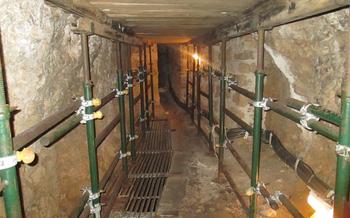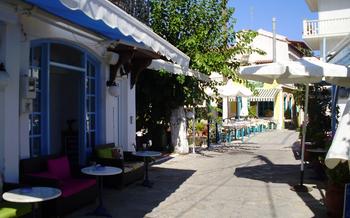
Paleontological Museum of Mitilinii
- The Antiquity of Samos
- Mitilinii Village: A Picturesque Haven Amidst Nature's Splendor
- The Paleontological Museum of Mitilinii
- Home to Samos' Fossil Treasures
- Exploring the Museum's Exhibits
- The Miocene Epoch
- Samos' Unique Fossils
- Educational Programs and Workshops
- Guided Tours
- Accessibility and Facilities
- Admission and Hours of Operation
- Getting to Mitilinii
- Nearby Attractions:
- Planning Your Visit
- Insider Tip:
The Antiquity of Samos
Samos, an island steeped in history, boasts a rich and diverse past dating back to the Bronze Age. During ancient times, it emerged as a prominent center of the Ionian League, a powerful alliance of Greek city-states. Samos' strategic location in the Aegean Sea allowed it to flourish as a maritime and commercial hub, contributing significantly to the development of Greek culture and civilization. The island's legacy extends beyond ancient times, with its transition to modern Greece and its current status as a popular tourist destination. Visitors to Samos can immerse themselves in the island's rich history by exploring its ancient ruins, museums, and cultural landmarks, gaining a deeper appreciation for its enduring significance.
Mitilinii Village: A Picturesque Haven Amidst Nature's Splendor
Nestled on the northern coast of Samos, Mitilinii is a charming village that exudes a timeless allure. Surrounded by lush vegetation and stunning landscapes, it offers a tranquil retreat for those seeking respite from the hustle and bustle of modern life. The village is a testament to the harmonious blend of nature and culture, where traditional architecture seamlessly integrates with the surrounding environment.
Strolling through the narrow cobblestone streets of Mitilinii, visitors are transported back in time. Quaint houses with whitewashed walls and colorful shutters, adorned with vibrant bougainvillea, line the streets, creating a picturesque scene. The village's traditional tavernas and cafes invite visitors to savor the flavors of local cuisine while immersing themselves in the warm hospitality of the locals.
Mitilinii's inhabitants are known for their friendly and welcoming nature, maintaining strong ties to their cultural heritage. Daily life in the village revolves around the traditions and customs that have been passed down through generations. Visitors can witness the locals engaging in traditional crafts, such as pottery, weaving, and embroidery, keeping the village's cultural legacy alive.
The Paleontological Museum of Mitilinii
Home to Samos' Fossil Treasures
The Paleontological Museum of Mitilinii is a remarkable institution dedicated to preserving and showcasing the rich fossil heritage of Samos. Established in 1995, the museum houses an extensive collection of fossils that provide a glimpse into the island's diverse geological history.
The museum's mission is to promote paleontological research, educate the public about the importance of fossils, and raise awareness about the need to protect Samos' natural heritage. Through its exhibits, educational programs, and outreach activities, the museum plays a crucial role in fostering an understanding and appreciation of the island's unique fossil record.
The museum's collection is divided into several sections, each focusing on a specific period or aspect of Samos' geological history. Visitors can explore the Miocene epoch, when Samos was home to a diverse array of marine and terrestrial life, and learn about the unique conditions that led to the island's rich fossil record from this period.
Highlights of the collection include giant ammonites, prehistoric mammals, and ancient plants, all of which offer valuable insights into the evolution of life on Samos and the Mediterranean region. Interactive exhibits and educational activities further enhance the visitor experience, making the Paleontological Museum of Mitilinii a must-visit destination for anyone interested in paleontology and natural history.
Exploring the Museum's Exhibits
The Paleontological Museum of Mitilinii offers a diverse range of exhibits and displays that showcase the rich fossil record of Samos. The exhibits are arranged chronologically, providing visitors with a comprehensive understanding of the evolution of life on the island.
One of the highlights of the museum is the collection of giant ammonites, which are fossilized remains of ancient marine creatures. These impressive fossils offer a glimpse into the diverse marine ecosystem that existed on Samos during the Miocene epoch. Visitors can also see fossilized remains of prehistoric mammals, including the Deinotherium, a massive elephant-like creature that once roamed the island.
The museum also features a collection of ancient plants, including fossilized leaves, seeds, and pollen. These fossils provide valuable insights into the vegetation that covered Samos during different geological periods.
To enhance the visitor experience, the museum offers interactive exhibits and educational activities. Visitors can touch and examine real fossils, watch educational videos, and participate in hands-on activities that help them learn more about paleontology and the natural history of Samos.
The Miocene Epoch
The Miocene epoch holds immense significance in Samos' geological history. It was during this period, approximately 23 to 5 million years ago, that the island experienced exceptional conditions that led to the formation of its rich fossil record. The unique geological and climatic factors that prevailed on Samos during the Miocene created a diverse array of marine and terrestrial ecosystems, resulting in a remarkable diversity of life.
The Miocene epoch on Samos is characterized by the presence of vast and shallow seas that covered much of the island. This marine environment fostered a thriving ecosystem teeming with a wide variety of marine creatures, including giant ammonites, diverse species of mollusks, and numerous fish species. On land, lush forests and woodlands flourished, providing habitats for a variety of terrestrial animals, including mammals such as primitive elephants, rhinoceroses, and giraffes.
The fossil record from the Miocene epoch on Samos offers a glimpse into the evolutionary history of life in the Mediterranean region. The island's fossils have played a crucial role in understanding the origins and diversification of many species and have contributed significantly to our knowledge of ancient ecosystems. Ongoing research and discoveries on Samos continue to shed light on this fascinating period of geological history.
Samos' Unique Fossils
Samos is home to a remarkable collection of unique and endemic fossils that provide valuable insights into the island's geological and biological history. Among the most notable fossils are the giant ammonites, which are some of the largest and best-preserved specimens in the world. These ancient marine creatures, with their intricate spiral shells, offer a glimpse into the diverse marine ecosystems that once thrived in the Samos Basin.
Another unique fossil found on Samos is the Samotherium, an extinct relative of the rhinoceros. This prehistoric mammal, which roamed the island during the Miocene epoch, is known for its distinctive three-horned skull. The discovery of Samotherium fossils has shed light on the evolutionary history of mammals in the Mediterranean region.
In addition to these iconic fossils, Samos has yielded a wealth of plant fossils, including fossilized leaves, seeds, and fruits. These plant fossils provide evidence of the island's diverse and changing vegetation over millions of years. The study of Samos' plant fossils has contributed to our understanding of ancient climates and ecosystems in the region.
The ongoing research and discoveries on Samos continue to add to our knowledge of the island's unique fossil heritage. New fossil sites are being explored, and new species are being identified, further enriching our understanding of the ancient life that once inhabited this remarkable island.
Educational Programs and Workshops
The Paleontological Museum of Mitilinii is dedicated to promoting paleontology and environmental education. It offers a range of educational programs and workshops tailored to visitors of all ages and interests. The museum collaborates with local schools and universities to provide educational resources and hands-on learning experiences for students. Outreach programs are also conducted to engage the local community and foster an appreciation for Samos' natural heritage.
One of the most popular programs is the "Fossil Discovery Workshop," where participants can learn about the techniques of fossil hunting and preparation. They get a chance to examine real fossils, make casts and molds, and even take home their own fossil discoveries. The museum also hosts specialized workshops on topics such as paleoecology, stratigraphy, and evolutionary biology. These workshops are led by experts in the field and provide an in-depth exploration of various aspects of paleontology.
Guided Tours
The Paleontological Museum of Mitilinii offers guided tours to enhance the visitor experience and provide deeper insights into the museum's exhibits. These tours are led by knowledgeable and experienced guides who can answer questions, share interesting stories, and point out the most significant fossils on display.
Guided tours are available in various languages, including English, Greek, French, and German, to accommodate international visitors. They typically last for about an hour and cover the museum's main exhibits, including the evolution of life on Samos, the unique fossils found on the island, and the importance of the Miocene epoch.
Visitors can choose from general tours that provide an overview of the museum's collection to specialized tours that focus on specific topics, such as marine fossils, plant fossils, or the geology of Samos. School groups can also arrange guided tours tailored to their educational needs.
By taking a guided tour, visitors can gain a deeper understanding of the museum's exhibits and the significance of Samos' paleontological heritage. The guides' expertise and enthusiasm bring the fossils to life and make the museum experience more engaging and informative.
Accessibility and Facilities
The Paleontological Museum of Mitilinii is committed to providing a welcoming and inclusive environment for all visitors. The museum is fully accessible, with ramps and elevators available for those with mobility challenges. Visitors can also request assistance from the museum staff, who are always happy to help.
The museum offers a range of facilities to enhance the visitor experience. These include a well-stocked gift shop where visitors can purchase souvenirs, books, and educational materials related to paleontology and the island of Samos. There are also clean and well-maintained restrooms available for visitors' convenience.
Guided tours are available in multiple languages, including English, Greek, French, and German. These tours provide visitors with expert insights and personalized explanations of the museum's exhibits and collections. Visitors can book guided tours in advance or inquire about availability upon arrival at the museum.
Admission and Hours of Operation
The Paleontological Museum of Mitilinii offers affordable admission fees to provide accessibility to visitors from all backgrounds. General admission tickets are available, and discounted rates are offered for students, seniors, and families, making it an excellent destination for educational excursions.
The museum follows regular operating hours, typically opening from Tuesday to Sunday during the morning and afternoon. However, it's advisable to check the museum's official website or contact them directly for the most up-to-date information on admission fees, discounts, and hours of operation.
To ensure a more enjoyable and personalized experience, it's recommended to visit the museum during the off-season or on weekdays when there are fewer crowds. This allows visitors to take their time exploring the exhibits, ask questions to the knowledgeable staff, and fully immerse themselves in the museum's fascinating collection of fossils.
Getting to Mitilinii
To reach the charming village of Mitilinii, nestled on the north coast of Samos, several transportation options are available. From Samos Town, the island's capital, regular buses depart, offering a convenient and affordable mode of transport. The journey by bus takes approximately 45 minutes, allowing you to sit back and enjoy the scenic countryside views.
For those who prefer a more flexible option, taxis are readily available at Samos Town's main taxi rank or can be arranged through your hotel or accommodation. The taxi ride to Mitilinii takes around 30 minutes, providing a direct and comfortable transfer to the village.
If you're looking for the freedom to explore Samos at your own pace, consider renting a car. Several car rental agencies operate on the island, offering a wide range of vehicles to suit your needs. With a rental car, you can easily navigate the island's well-maintained roads and discover hidden gems and secluded beaches at your leisure.
To assist you in finding your way to Mitilinii, a detailed map or directions can be obtained from the tourist information office in Samos Town or online. Whether you choose to travel by bus, taxi, or rental car, the journey to Mitilinii promises to be a delightful experience, immersing you in the beauty of Samos' natural landscapes.
Nearby Attractions:
Exploring beyond the Paleontological Museum of Mitilinii, visitors can immerse themselves in the captivating tapestry of Samos' natural and cultural treasures. The village of Mitilinii itself offers a serene escape amidst picturesque landscapes, inviting visitors to stroll along its charming cobblestone streets and soak in the tranquil atmosphere. A short drive from the village leads to pristine beaches, where crystal-clear waters and golden sands beckon for relaxation and rejuvenation.
For those seeking active pursuits, Samos boasts an array of hiking trails that wind through lush forests, offering breathtaking panoramas of the island's diverse terrain. History buffs can delve into the island's rich past at ancient sites like the Temple of Hera, a testament to Samos' significance in the classical world.
Furthermore, Samos is renowned for its vibrant cultural scene, with traditional festivals and events showcasing the island's unique heritage. Visitors can experience the infectious rhythm of Greek music, savor the delectable flavors of local cuisine, and immerse themselves in the warmth and hospitality of the Samian people.
A visit to the Paleontological Museum of Mitilinii can be seamlessly combined with other attractions on Samos, creating a comprehensive and enriching travel experience that unveils the island's multifaceted charms.
Planning Your Visit
To make the most of your visit to the Paleontological Museum of Mitilinii, careful planning is essential. Consider visiting during the shoulder seasons (spring or autumn) to avoid the summer crowds and enjoy more pleasant weather. Combine your visit to the museum with other attractions on Samos, such as the ancient city of Pythagoreion, the beaches of Kokkari, or the hiking trails of Mount Kerkis. Pack comfortable shoes for walking, sunscreen to protect yourself from the Mediterranean sun, and a camera to capture the unique fossils and exhibits. Remember that the museum is closed on Mondays, so plan your visit accordingly. With a little preparation, you can ensure a memorable and enriching experience at the Paleontological Museum of Mitilinii.
Insider Tip:
Uncover the hidden gem of the Paleontological Museum of Mitilinii by venturing to the museum's rooftop terrace. This secluded spot offers breathtaking panoramic views of the village, the surrounding countryside, and the shimmering Aegean Sea. Escape the crowds and enjoy a moment of tranquility as you soak in the beauty of Samos from a unique perspective. Don't forget your camera to capture the stunning vistas and create lasting memories of your visit to this special place.
